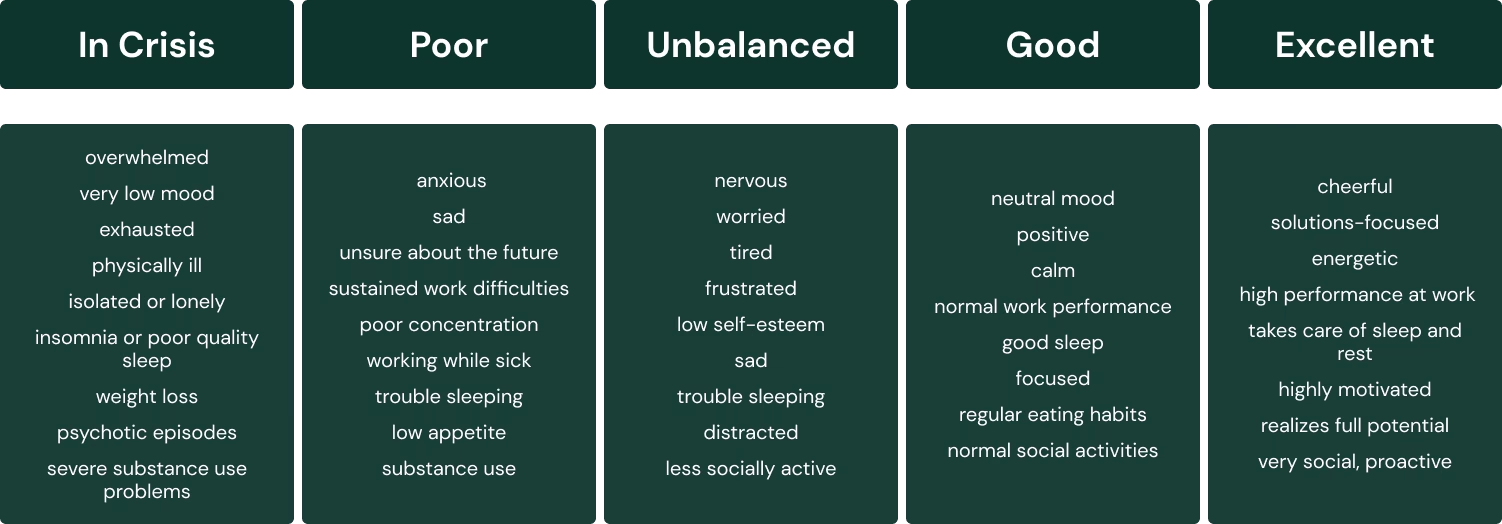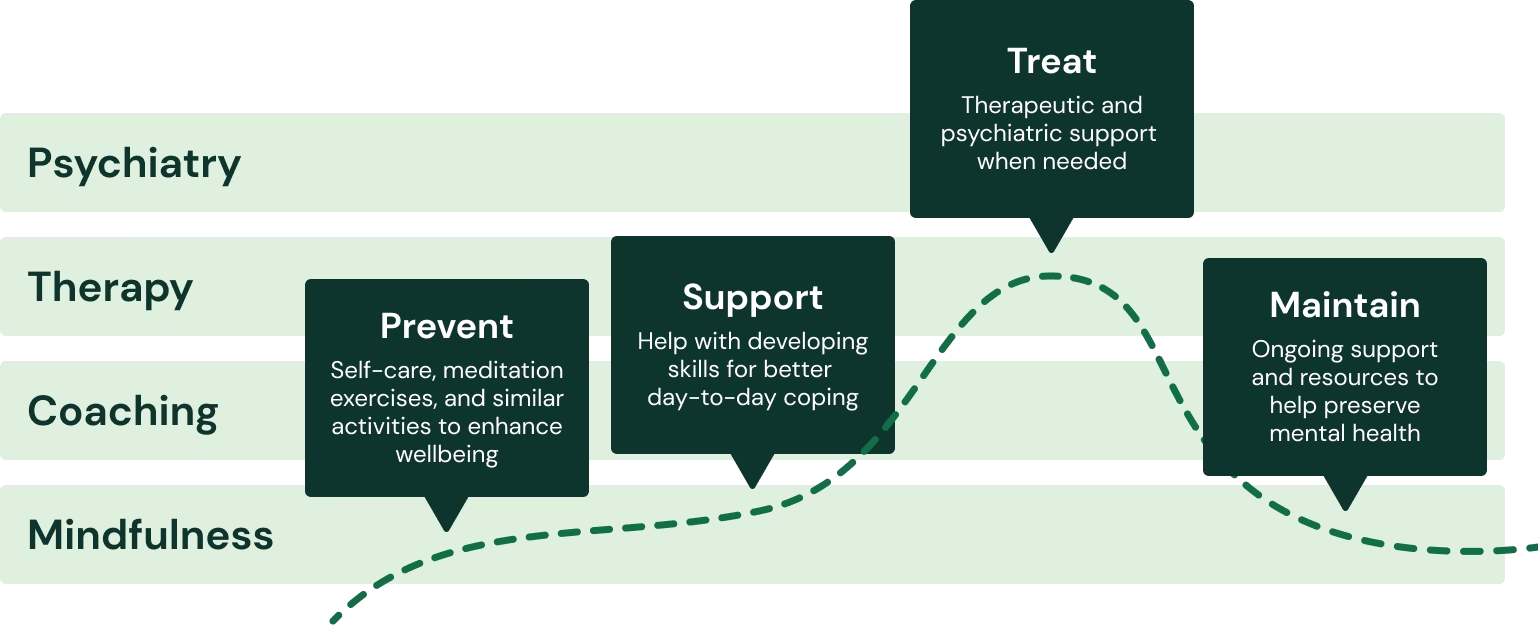Why is mental health at work so important and what can employers, managers, and employees do to support it? We explore these questions and more in this article.
Fortunately, the stigma around mental health in the workplace has decreased in recent years. And that’s a necessary shift—each year, more than 30% of working adults in Germany experience mental health challenges, often linked to their jobs.
In a company with around 300 employees, that means about 100 people are affected. This has a clear impact on productivity, satisfaction, creativity, and motivation.
In this article, you’ll find out how to support people on your team and why investing in mental health at work also pays off for your organization.
Why mental health at work matters
Die Zeiten, in denen mentale Gesundheit ausschließlich als privates Thema betrachtet wurde, sind vorbei. Immer mehr Unternehmen erkennen, wie wichtig das psychische Wohlbefinden im betrieblichen Kontext ist, und integrieren es zunehmend in ihr betriebliches Gesundheitsmanagement (BGM) oder ihre Strategien zur Mitarbeiterbindung.
The days when mental health was seen as a purely private matter are over. More and more companies are recognizing how important psychological well-being is in the workplace and are integrating it into their occupational health management programs or employee retention strategies.
Recent data from the EU, federal government, and state authorities make it clear just how crucial it is for employers to take action:
- 12 billion workdays lost per year
Mental health issues are projected to cost the global economy around $16 trillion by 2030—largely due to lost productivity. - Rising share of sick leave due to mental illness
Today, 17.5% of all work-related illnesses are attributed to mental health issues. Around 25 years ago, that figure was just 2%. - Mental illness is the second most common reason for sick leave
Only musculoskeletal disorders lead to more days off work. - Mental health-related absences last three times longer
On average, mental health-related sick leave lasts 38.9 days, compared to 13.2 days for other illnesses.
These figures highlight how serious the consequences of mental health issues can be—not just in people’s private lives, but in the workplace too.
In Germany, mental health-related sick leave is estimated to cost companies over €2,000 per employee each year. On top of that, rising employee turnover and the resulting loss in productivity create additional financial pressure.
If your company manages to avoid even a portion of these costs, investing in mental health is already worth it. According to the World Health Organization (WHO), the return on investment is striking:
For every euro your company invests in employee mental health, you can expect a four-euro gain in productivity.
How companies benefit from supporting mental health at work
Beyond the potential cost savings, promoting mental health in the workplace offers a wide range of additional benefits. Alongside increased employee productivity, these include:
- Stronger employee retention
People who are more satisfied at work are more likely to stay. Studies show that around 34% of employees left their previous job due to mental health-related stress. - A stronger employer brand
A solid mental health program not only improves employee loyalty—it also makes your company more attractive to potential candidates. - Greater employee satisfaction
When people feel comfortable and supported at work, they’re more motivated and productive. That positive energy spreads to others. Healthy minds and bodies are the foundation of a healthy, satisfied workforce. - Increased resilience
Good mental health helps employees become more resilient, and in turn strengthens the organization’s ability to navigate challenges and crises. - More creativity
People can only tap into their creative potential when they feel well. And in business, no creativity means no innovation.
Key drivers and risk factors for mental health in the workplace
If your company wants to promote mental health, there are several key factors that research has identified as especially important:
- Work culture and leadership
A positive work environment naturally supports mental well-being. On the other hand, frequent conflicts within teams or with managers can increase emotional stress and anxiety. - Individual and team workload
This is closely linked to stress and burnout. What matters most isn’t the actual workload, but how it’s perceived by each person. What feels manageable to one employee may overwhelm another. And a word of caution: too little work can also be harmful and lead to a boreout. - Job insecurity
Employees who are frequently threatened with layoffs or constantly hear about poor financial performance in team meetings will inevitably worry about their job. This insecurity can be paralyzing – or lead to overwork and eventual burnout. - Sense of community and collegiality
We’re social beings, and the quality of workplace relationships matters. When people feel supported by their team, they’re more cooperative and willing to help each other. - Work-life balance
Companies should ask themselves how they can support employees in balancing personal appointments and responsibilities with their professional lives – for example, through flexible working hours or hybrid models. - Autonomy and decision-making power
Whether it’s about working hours, location, or environment, the general rule is: the more autonomy and flexibility employees have in shaping their work, the more satisfied they tend to be.
As you can see, mental health in the workplace is a complex and deeply individual topic. Mental well-being isn’t static—it changes throughout our lives, is heavily influenced by external factors, and requires ongoing attention. Just like physical health, staying mentally fit and well means taking proactive steps.
Personal and professional aspects of life also constantly influence one another. So if your company is serious about supporting mental health, you can’t ignore employees’ personal challenges entirely. Instead, consider them with the appropriate level of care and discretion.
The mental health spectrum
When we talk about mental health, it’s not just a question of being “happy” or “mentally ill.” Mental well-being exists on a spectrum. The transitions between different states are fluid and unique to each individual.

We’re constantly moving along this spectrum—sometimes we feel better, sometimes worse. That’s completely normal. This makes it all the more important for companies to offer a variety of measures that meet people where they are and provide the right support for their situation.
In practical terms, this means:
- Vorbeugen und fördern: solange es gut geht
- Unterstützen: wenn in einem bestimmten Bereich Hilfe benötigt wird
- Behandeln: sobald eine Intervention notwendig wird
- Aufrechterhalten: nachdem ein positives Befinden wiederhergestellt wurde

In a workplace setting, mental well-being also includes personal growth. This is especially important for top performers—they’re not looking for generic training programs, but rather personalized support. A mental health initiative can address this need by offering options like one-on-one coaching.
What companies can do
What employers are required to do for mental health in the workplace
Under German occupational health and safety law (ArbSchG), employers are explicitly required to address mental health in the workplace:
“(1) The employer must assess the risks […] to determine which occupational health and safety measures are necessary. […] (3) A risk may arise in particular from: 1. the design and layout of the workplace and workstation, […] 6. psychological strain at work.”
ArbSchG, Section 5: Assessment of working conditions
So beyond the many benefits of promoting mental health at work, it is your legal obligation as an employer to address this topic. However, before implementing specific measures, it’s a good idea to do some groundwork.
5 steps to creating the right workplace mental well-being program
Every person is different—and so is every company. That’s why mental well-being programs should be tailored to your organization. To help you find the right measures and activities, we recommend these five steps:
- Assess the current situation
A good starting point could be an employee survey to understand needs and challenges. - Define your strategy and goals
Identify areas for improvement and discuss within your team what you want your program to achieve. Also think about how you’ll measure success. - Select appropriate measures
The list of possible activities and offerings can seem endless. Start with a small, manageable selection and adjust based on feedback and engagement. - Use the right tools and partners
Compared to traditional Employee Assistance Programs (EAPs), platforms like nilo offer a diverse mix of activities to meet employees where they are in terms of their mental well-being. - Measure success and optimize
Regularly track progress toward your goals and be ready to adjust your approach if needed.
Company culture as the foundation for mental well-being at work
Damit sich eure Mitarbeitenden mental wohlfühlen, braucht es eine solide Grundlage – und die bildet eure Unternehmenskultur.
For employees to feel mentally well, they need a strong foundation—and that foundation is your company culture.
Key pillars of a mentally healthy company culture include:
- Autonomy and decision-making power
- A realistic and manageable workload
- Mutual appreciation across departments and hierarchies
- Open dialogue around mental health topics
- Collaborative conflict resolution
- Reasonable working hours
- Job security
- Opportunities for personal and professional development
- A strong culture of communication and feedback
- Targeted mental health training for managers
But it’s not just up to employers. Managers and employees themselves also have a role to play.
What managers can do
Your managers play a key role in establishing and promoting mental health in your organization.
They are the ones who lead by example, bring your company culture to life, and keep an eye on the mental well-being of their team members.
How your managers can lay the foundation for mental well-being in their teams
Leading by example and practicing “mindful leadership” means, for managers, doing things like:
- Creating work-life balance for themselves and their teams (for example, by avoiding sending emails to someone on vacation and scheduling them to be sent after their return)
- Speaking openly about their own mental health and helping remove the stigma around the topic
- Regularly checking in with employees, asking how they’re really doing, and actively offering support when needed
- Easing pressure by setting goals and deadlines together—and adjusting them when necessary
- Communicating goals, expectations, and assignments as clearly and transparently as possible
- Considering and respecting individual needs and preferences
- Expressing and showing appreciation on a regular basis
- Organizing informal check-ins or team activities on a regular basis (virtually if needed)
What employees can do
How employees can build a foundation for mental health at work
It’s important to understand that employees also carry responsibility for their own mental health—after all, they know best how they’re doing and what they need. That’s why it’s essential to recognize and clearly communicate those needs.
Here are 7 self-care tips:
- Pay attention to basic needs like sleep, nutrition, and physical activity.
- Take regular breaks and schedule time to rest.
- Set clear boundaries between work and personal life.
- Build small, restorative rituals into your daily routine.
- Stay connected with others and seek out meaningful interaction.
- Make time for relaxation and mindfulness.
- Reflect regularly on how you’re feeling, and adjust habits and routines as needed.
It can also be helpful to speak with a coach or psychologist regularly—and you don’t need to wait until you’re struggling. Proactive conversations support mental health, help build resilience, and make it easier to find solutions early when challenges arise.
These tools and structural can support employees
For employees to take care of their mental well-being, they need more than just a workplace culture that makes space for it (see above). They also need clear points of contact and practical tools, such as:
- Courses and content on topics like resilience and stress at work
- Coaching, counseling, and support services—both in times of crisis and for anyone looking to improve or work on their mental well-being
- Employee check-ins where staff can share feedback and are actively asked for their opinions
- Mindfulness exercises and courses (e.g. digital mindfulness to help reduce everyday information overload)
- Comfortable break areas where people can meet, connect, and truly unwind
- Internal health campaigns—covering both mental and physical well-being
The bottom line: Mental health at work concerns all of us. A successful mental health program involves everyone and offers flexible measures that meet people where they are in their mental well-being journey.







